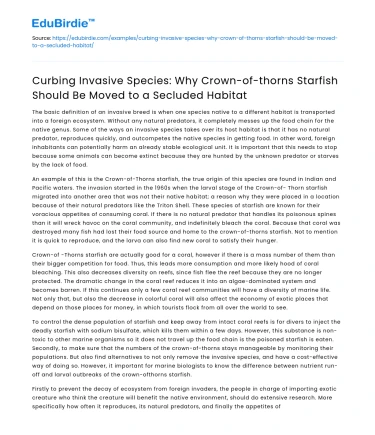The basic definition of an invasive breed is when one species native to a different habitat is transported into a foreign ecosystem. Without any natural predators, it completely messes up the food chain for the native genus. Some of the ways an invasive species takes over its host habitat is that it has no natural predator, reproduces quickly, and outcompetes the native species in getting food. In other word, foreign inhabitants can potentially harm an already stable ecological unit. It is important that this needs to stop because some animals can become extinct because they are hunted by the unknown predator or starves by the lack of food.
An example of this is the Crown-of-Thorns starfish, the true origin of this species are found in Indian and Pacific waters. The invasion started in the 1960s when the larval stage of the Crown-of- Thorn starfish migrated into another area that was not their native habitat; a reason why they were placed in a location because of their natural predators like the Triton Shell. These species of starfish are known for their voracious appetites of consuming coral. If there is no natural predator that handles its poisonous spines than it will wreck havoc on the coral community, and indefinitely bleach the coral. Because that coral was destroyed many fish had lost their food source and home to the crown-of-thorns starfish. Not to mention it is quick to reproduce, and the larva can also find new coral to satisfy their hunger.
Save your time!
We can take care of your essay
- Proper editing and formatting
- Free revision, title page, and bibliography
- Flexible prices and money-back guarantee
Crown-of -Thorns starfish are actually good for a coral, however if there is a mass number of them than their bigger competition for food. Thus, this leads more consumption and more likely hood of coral bleaching. This also decreases diversity on reefs, since fish flee the reef because they are no longer protected. The dramatic change in the coral reef reduces it into an algae-dominated system and becomes barren. If this continues only a few coral reef communities will have a diversity of marine life. Not only that, but also the decrease in colorful coral will also affect the economy of exotic places that depend on those places for money, in which tourists flock from all over the world to see.
To control the dense population of starfish and keep away from intact coral reefs is for divers to inject the deadly starfish with sodium bisulfate, which kills them within a few days. However, this substance is non-toxic to other marine organisms so it does not travel up the food chain is the poisoned starfish is eaten. Secondly, to make sure that the numbers of the crown-of-thorns stays manageable by monitoring their populations. But also find alternatives to not only remove the invasive species, and have a cost-effective way of doing so. However, it important for marine biologists to know the difference between nutrient run-off and larval outbreaks of the crown-ofthorns starfish.
Firstly to prevent the decay of ecosystem from foreign invaders, the people in charge of importing exotic creature who think the creature will benefit the native environment, should do extensive research. More specifically how often it reproduces, its natural predators, and finally the appetites of these exotic specimens. The person should also predict how the potential new animal would influence their new environment and if they can potentially rob the habitat from its native occupants. In order for this incident not to occur, cargo should be checked for any exotic animals. If so there at least should be a limited number in which you could bring, and have animals that will not disrupt an already stable ecosystem.






 Stuck on your essay?
Stuck on your essay?

